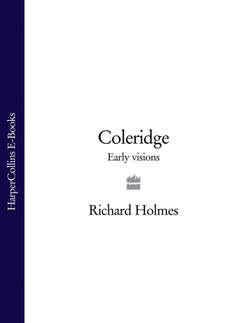Читать книгу Coleridge: Early Visions - Richard Holmes - Страница 24
8
ОглавлениеOfficially his career at Christ’s Hospital ended in triumph. As the senior Grecian in his year, he was awarded in January 1791 a School Exhibition worth £40 to take him to Cambridge, renewable for four years; and the following month obtained a place at Jesus College, with a promise of a Rustat Scholarship of £30, especially reserved for the sons of clergymen who showed outstanding merit. Bob Allen went to Oxford without an award, and Val Le Grice did not go up for another year. These awards delighted his family – especially George – and promised to relieve them of most of his expenses, which normally would have been more than £100 per annum.
Yet throughout that last winter Coleridge was periodically ill with rheumatic fever, contracted as a result of a late autumn bathing expedition to the New River. For several months he spent long periods in the school sanatorium, dosed with opium to help him sleep, and doing little except write some striking scraps of poetry. He lay listening to the distant shouts and laughter of the boys in the cloisters, as he recorded in his sonnet “Pain”. Coleridge’s long history of illness – often recurring in damp climates, and during winter months – now began. The sonnet is his first vision of the feverish invalid, besieged by “the trembling sense of wan Disease”, cut off from the normal, healthy daylight world around him, a theme to be powerfully developed.37
He also wrote a love-poem, “Genevieve”, addressed to his young nurse, whose short lyrical lines contain the first hint of the ballads he would later write. They praise her tender solicitude and generous, maternal bosom in its starched apron like a swan:
When sinking low the sufferer wan
Beholds no hand outstretch’d to save,
Fair, as the bosom of the Swan
That rises graceful o’er the wave,
I’ve seen your breast with pity heave,
And therefore love I you, sweet Genevieve!38
The close association of poetry with sickness, feverish dreams, and isolation, set against the consoling, healing presence of the beloved, was now initiated. The theme was deepened by tragic sickness in his own family. Early in 1791 came news of Luke’s sudden death of a fever at Exeter; and this was quickly followed by the death of his beloved Nancy, after a long consumptive illness. Again, Coleridge turned to poetry, writing several more sonnets of deep and clumsy emotion:
Pain after pain, and woe succeeding woe –
Is my heart destin’d for another blow?
O my sweet sister! and must thou too die?39
Significantly, he already linked these deaths with that of his father, and the sense of being “fated to rove thro’ Life” bereft of those who had been closest to him in childhood. Perhaps this also explains the intense emotion with which he finally left Christ’s Hospital that summer, celebrated in his “Sonnet: On Quitting School for College” (another theme taken from Bowles). He bid “Adieu, adieu!” to the “much-lov’d cloisters pale!”, and spoke in tears of his happy days there, most of which he would later say were miserable.40
